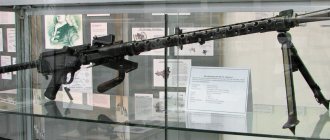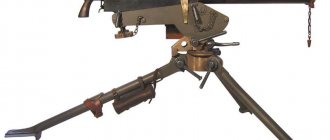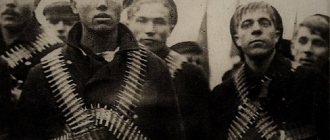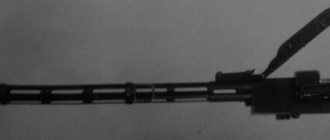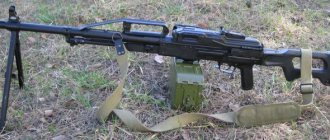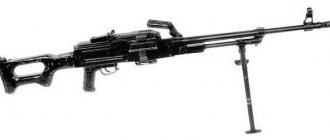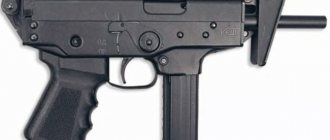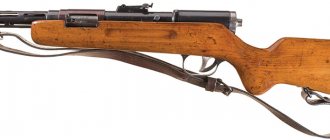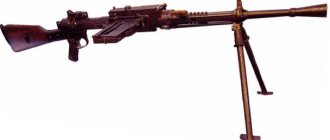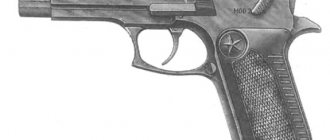Aviation heavy machine gun YakB-12.7 of the Yakushev and Borzov system
USSR, testing began at the end of 1969.
USPU-24 installation with a YakBYU-12.7 heavy machine gun on a Mi-24V helicopter Photo: NiT Archive
YakB-12.7 (TKB-063, 9A624) serial , heavy machine gun with an increased rate of fire for combat helicopters.
The creation of a machine gun with an increased rate of fire was envisaged back in 1966 for arming new combat helicopters - the Mi-24 (V-24, a new development by the Moscow Helicopter Plant, General Designer M.L. Mil) and the Ka-25F (a modification of the Ka-25 naval helicopter developed by UVZ, General Designer N.I. Kamov), but the Council of Ministers and the State Planning Committee of the USSR did not release the relevant documents in a timely manner, which delayed the work.
The development was officially established by Resolution of the Council of Ministers of the USSR No. 1044-381 of December 26, 1968. Although the work began before the release of the Resolution, it was hampered by a lack of funding.
By that time, the TKB team already had experience in creating multi-barrel systems - the first in its practice was the GSh6-30 cannon, used in aviation and naval installations.
Multi-barrel systems developed by TKB - from left to right the six-barreled GSh6-23 cannon, the GSh6-30 cannon and the YakB-12.7 machine gun Photo: S.G. Freezing
The machine gun was intended to destroy enemy personnel, unarmored and lightly armored vehicles by attacking them at high speeds with maneuvering, which determined the following general requirements for it:
- ballistics (firing range) and armor penetration are no worse than that of the serial A-12.7 machine gun of the Mi-24A helicopter;
- the rate of fire is significantly higher than that of the serial A-12.7 machine gun;
- Possibility of use in both fixed (including suspended) and mobile remote-controlled helicopter installations.
The responsible executor was determined to be the Instrument Design Bureau (Tula).
The design of the machine gun, which received the factory designation TKB-063, was directly headed by Pyotr Gerasimovich Yakushev (09/17/1919-02/17/1973) and Boris Afanasyevich Borzov (03/09/1944 - 04/21/2002).
Outstanding Soviet small arms designer Pyotr Gerasimovich Yakushev (09/17/19-02/17/73) - co-author of the YakB-12.7 aircraft machine gun Photo: https://www.yakushev.info/bio
Outstanding Soviet small arms designer Boris Afanasyevich Borzov (03/09/1944 - 04/21/2002) - co-author of the YakB-12.7 aircraft machine gun Photo: https://www.museum-arms.ru/about/tula-armory/detail.php ?ELEMENT_ID=2074
Design Features:
- to ensure the required rate of fire, for the first time in domestic practice, the machine gun was made in a four-barrel design with a rotating block of barrels (by that time, KBP already had experience in creating such systems of 30 and 23 mm caliber);
Aviation machine gun YakB-12.7 - unit for installing a barrel block Photo: S.G. Freezing
- automation drive – cam-type gas engine, see below;
- gases for engine operation are taken from the barrels with each shot;
- the spin-up of the block of barrels is carried out with each burst of shots from a pyro-spring starter device, which stores energy at the end of the burst of shots when the block is braking and the last two cartridges in the burst of shots are fired at this moment;
Aviation machine gun YakB-12.7 - the spring of the starter device is visible between the barrels Photo: S.G. Freezing
- the impact of the shutters in the rearmost position is softened by the buffer device;
- a mechanism for changing the rate of fire is installed;
- the weapon is powered from a continuous metal strip;
- Electric release.
Design and principle of operation of a gas engine and starter:
- a torsion-type starter device is located between the barrels;
- before a combat mission, the spring of the starter device, placed on the torsion shaft, is compressed;
- when firing the first shot, the spring expands and sets in motion the rotating block of barrels, as well as the remaining moving parts of the machine gun’s automation;
Aviation machine gun YakB-12.7 - gas engine and automation unit, cord with electric trigger connection connector Photo: S.G. Freezing
- gases from the first shot power the gas engine;
- the gas engine consists of a single piston covering a gas coupling with two cavities that is common to all barrels;
- gas outlet holes from each barrel are inserted into these cavities so that the powder gas with each shot enters sequentially into different cavities, forcing the piston to perform reciprocating movements;
- the stationary copier converts this movement of the piston into rotation of the barrel block, and it activates the rest of the machine gun’s automation;
- when firing stops, when the last two cartridges are fired, the spring of the torsion device is cocked, and it again accumulates energy to resume firing;
- In the event of a failure, for example, a cartridge misfires, the stopped block of barrels is spun up using a squib (there are three of them).
Aviation machine gun YakB-12.7 - view of the rear part of the gas engine and automation unit Photo: S.G. Freezing
Applicable ammunition:
- two-bullet cartridge 1SL (index GRAU 9-A-4012) with an ordinary bullet to destroy manpower and lightly armored vehicles at a range of 1000...1500 m, the tip of the bullet is unpainted;
- two-bullet tracer cartridge 1SLT (GRAU index 9-A-4427) for target designation and fire adjustment when shooting at manpower and equipment at a distance of up to 1000 m (according to ballistics, the tracer burning range is 1500 m, bullet tracing time is at least 2.9 s ), the tip of the bullet is painted green;
- single-bullet cartridge with an armor-piercing incendiary bullet BS (7-BZ-1) for combating ground-based lightly armored vehicles, air targets and manpower in personal armor at long firing ranges (a “heavy” bullet weighing 56.6 g has improved ballistics - by a range of 500 m penetrates a 20-mm armor plate with an impact angle of 20 degrees).
Design features of two-bullet cartridges:
- the 12.7×108 mm two-bullet cartridge has a brass sleeve and bullets with a bimetallic jacket into which steel and lead cores are pressed;
- inside the cartridge case, behind the main bullet, a second bullet is placed; to secure it, a core is made in the central part of the cartridge case, which also serves as an identification mark of such a cartridge;
- cartridge weight 145 g, length - 147 mm;
- the mass of the first bullet is 31 g, the second - 27 g.
Two-bullet cartridges were developed specifically for the YakB machine gun by specialists from TsNIITochMash (Klimovsk) under the leadership of BM Sabelnikov.
The production of these cartridges has been mastered at the Novosibirsk Cartridge Plant. Although the presence of two bullets in the cartridge increased the dispersion of bullets (the radius of the better half of holes at a distance of 300 m is 50 cm, approximately 2.5 times worse than that of a conventional cartridge), the firing efficiency is 1.5 times higher due to the better lethality.
Aviation machine gun YakB-12.7 in the Aviation Museum of the Czech Ministry of Defense Photo: S.G. Freezing
The first stage of factory bench tests took place at the end of 1969 and showed a significant number of defects, the elimination of which required lengthy fine-tuning.
In 1971, flight tests of the machine gun began in the USPU-24 installation of experimental Mi-24B and Mi-24D helicopters, and since 1973 - Mi-24V, see.
In 1975, bench tests of a machine gun began as part of the gondola of the universal helicopter GUV-8700 (each is equipped with one YakB-12.7 machine gun and two GShGs - also four-barreled, but with a caliber of 7.62 mm, on a suspension for the Mig-24 - two gondolas ).
Serial production of YakB machine guns was mastered by the Kovrov Mechanical Plant.
In 1972, before the end of testing, production began, and in 1973, the supply of serial machine guns for the production and operation of Mi-24D helicopters began.
In 1977, the YakB-12.7 machine gun completed development and testing and was adopted by the Army Aviation of the USSR Air Force for the Mi-24D helicopter and its export modification Mi-25 in a unified small-arms mobile installation USPU-24, built into the nose of the fuselage, as well as in two gondolas of unified helicopters GUV-8700, suspended under the wing (firing only along the heading). Their tactical and technical data will be given in the section of the Handbook dedicated to the Mi-24D helicopter.
Further, YakB-12.7 machine guns were used on the following modifications of the Mi-24 helicopter:
- transport and combat Mi-24V and its export version Mi-35;
- reconnaissance and artillery fire spotter Mi-24K;
- radiochemical reconnaissance Mi-24R, RA;
- transport and combat all-weather Mi-24MO;
- transport and combat Mi-35M;
- transport and combat Mission 24 (modernization of Mi-25 and Mi-35 in Israel), etc.
USPU-24 installation with a YakB-12.7 heavy machine gun on a Mi-24V helicopter Photo: A.Yu. Oblamsky
By the time it was put into service, the machine gun had been in use for more than three years in combat units of the USSR Air Force Army Aviation and showed extremely high tactical data
The machine gun showed extremely high tactical data:
- 1000 / 1500 rds/min lower achieved. given, but still a very high practical rate of fire - 4000 / 4500 rounds per minute, there were reserves for increasing it (see YakBU-12.7);
- theoretically, the machine gun could fire a continuous burst of up to 400 rounds, after which it required cooling - a break in firing at temperatures above +10°C - 25 min/, from -10 to +10°C - 15 min/, at lower temperatures - 5 min., but the practical queue length turned out to be lower (see the disadvantages of the machine gun);
- armor penetration of a bullet with a steel core at an angle of impact with the target plane of 70 degrees. – 20 mm from a distance of 300 m, and at a right angle – from a distance of 350 m;
- the thickness of the earthen floor or adobe wall penetrated from a distance of 800...1000 m is 500 mm (in this case they are completely destroyed);
- survivability of the barrel block (according to other sources - the entire machine gun) 8000 rounds. (bulkhead after shooting every 5 full rounds of Mi-24 ammunition).
The first stage of operation took place in areas with a temperate climate (with low levels of dust exposure and mild temperatures in summer) and in peaceful conditions - in units of the USSR Army Aviation in the Far Eastern Military District, Western Military District, GSVG and SGV. In this case, the shooting was carried out in short bursts in accordance with the current instructions. Under these conditions, the machine gun worked normally. The main difficulty was the complexity of the design and maintenance technology of the new machine gun (all this was significantly different from the A-12.7 mastered by the troops).
The USPU-24 installation of the Mi-24D/V helicopter and other modifications, as well as the YakB-12.7 heavy machine gun mounted in it, were much more complex than the NUV-1 with the single-barreled A-12.7 - however, this was an inevitable price to pay for more than fourfold growth firepower and expansion of firing sectors Photo: NiT Archive
Mi-24D helicopters from the beginning of 1980 were widely used by the 40-A Air Force in Afghanistan, where conditions turned out to be more severe. This revealed some defects:
- from prolonged exposure to heat and sun (trunks must always be covered when parked);
- when firing in long bursts (which was often necessary depending on the situation), after 250 shots the machine gun began to fire an incomplete shot (“spitting”), causing the automatic operation to stop;
- if after 250 shots the automation was still working, then due to thermal expansion and deformation of the barrels, the initial velocity of the bullet dropped and its ballistics deteriorated, which affected the range, accuracy and accuracy of fire;
- when firing in long bursts, the tape in the feed mechanism becomes warped and jams, after which it is impossible to resume shooting (the defect was not in the machine gun, but in the USPU-24 installation and was eliminated during its modifications).
Because of this, the practical rounds fired on a combat mission usually did not exceed 500 rounds of ammunition, which did not allow using this weapon with proper efficiency and slowed down the equipment with a full load of ammunition for the next flight (and in some operations in Afghanistan their number per flight day reached 6, sometimes more ).
The above defects of the machine gun were eliminated on the modification YakBYu-12.7 - see below.
YakB-12.7 machine gun in the extremely raised position in the USPU-24 installation of the Mi-24D helicopter Photo: A. Artyukh
Also, at the manufacturer, in agreement with the Customer, the PSI procedure was simplified - the control shooting of each machine gun being delivered was replaced by a selective one, which deprived the military acceptance department of the ability to identify all defects before transferring each product to the troops. Such defects had to be eliminated during commissioning.
At the same time, the YakB-12.7 machine gun significantly improved the effectiveness of the Mi-24 helicopter as a combat system.
Its high characteristics are confirmed by the results of firing during tests, exercises and in combat situations:
- in August 1982, near the city of Kandahar in southern Afghanistan, the crew of the Mi-24 sub-ship of Alexandrov, with a burst from the YakB-12.7, destroyed the bus leading the convoy of vehicles of dushmans, which fell into pieces and everyone in it died;
Combat helicopter Mi-24V with a built-in mobile installation USPU-24 with a high-speed heavy machine gun YakB-12.7 under the nose of the fuselage in Afghanistan Photo: https://artofwar.ru/img/n/nagowicyna_e_s/text_0030-1/131747580.jpg
- During the Iran-Iraq war on October 27, 1982, the crew of a Mi-25 helicopter visually detected an Iranian Air Force F-4 Phantom-2 fighter, fired at it with a salvo of NARs from a distance of 2500 m, and then, taking advantage of the confusion of the enemy crew, shot it down with a YakB machine gun -12.7 – it fell near the city of Ein Khosh in western Iran.
Combat operation of machine guns in the basic version in the USSR Air Force was carried out until the early 1990s, when the modernized YakBYu-12.7 appeared, but a significant number of them remained in reserve among the troops.
Abroad, the operation of this type of machine gun on export modifications of Mi-24D, V, Mi-25 and Mi-35 helicopters continues.
YakBU-12.7 serial , large-caliber machine gun with an increased rate of fire for combat helicopters. A modification of the machine gun was created at KBP (Tula) with the participation of designer Yurischev with the aim of:
- The “fast” practical rate of fire has been increased from 4500 to 5000 rounds/min. (“slow” remained 4000 rounds/min.) due to a slight decrease in the rate of fire;
- elimination of the above shortcomings (the length of the continuous burst was increased to 700 shots);
- the survivability of the barrel block (according to other sources - a full machine gun) was increased by 1.5 times and reached 12,000 rounds. (8 full rounds of ammunition were fired before the machine gun was rebuilt). The weight of the machine gun increased by 15 kg (25%).
Maintenance of the USPU-24 installation with the YakBYu-12.7 machine gun of the Mi-24V helicopter of the Russian Armed Forces - Mozdok airfield, North Caucasus Military District, 1990s. Initially, a machine gun of this type was considered very “capricious” and required regular cleaning, but after modification it became much less demanding in terms of operating conditions, maintaining functionality even with this level of corrosion of parts Photo: A. Artyukh’s archive
In 1988, the machine gun was put into service for the same installations as the basic version.
Operation (including in combat conditions in Afghanistan, and then in Chechnya) showed that all the above defects have been eliminated. It continues to this day both on Mi-24V, K and R helicopters of Russian aviation, and outside the Russian Federation on their main and export modifications.
Overall rating of the machine gun
The YakB-12.7 machine gun is 1.6 times heavier than the replaced A-12.7, and the YakBU-12.7 machine gun is 2.1 times heavier, there is also a significant difference in the weight of their installations, but this did not significantly affect the ease of control them, nor on the flight data of modifications of the Mi-24 helicopter with new weapons. At the same time, its tactical qualities have increased significantly - the firing sectors have expanded horizontally and vertically, the second salvo at a “fast” rate of fire has increased by 4.7 times, and the muzzle power has increased by 4.4 times.
The firepower of a helicopter is significantly increased by the use of suspended gondolas with small arms and cannon weapons. At the same time, it is possible to conduct salvo fire from mobile weapons with a heading angle of 0 (straight ahead) and from two such gondolas. The use of two GUV-8700 (9A662) gondolas increases the second salvo by 3.9 times, and the muzzle power by 4.0 times.
At the same time, the GUV-8700 gondola has significant operational disadvantages:
- heavy weight (one equipped – 452 kg, set – 904 kg);
- complexity and duration of equipment;
- the difference in ballistics of the YakB-12.7 and GShG-7.62 machine guns installed in it;
- excess ammunition (which determined its heavy weight and was almost never used up all in one combat mission).
Equipment of the YakBYu-12.7 machine gun in the USPU-24 installation of the Mi-24V helicopter - its ammunition load was 1470 rounds in the combat version and 500 in the transport version Photo: NiT Archive
The use of UPK-23-250 gondolas with GSh-23L guns turned out to be more practical - they were lighter (the weight of one loaded one was 218 kg, the weight of a set was 436 kg), they gave an increase in second salvo by 5.6 times, and muzzle power by 4.6 times with the greater destructive effect of a 23 mm caliber projectile.
Open cartridge box of the USPU-24 installation of the Mi-24V helicopter Photo: N. Okolelov
The YakBU-12.7 machine gun, according to the developer, gives a 1.1-fold increase in the second salvo compared to the basic version at a high rate of fire, however, there is information that the practical rate of fire of machine guns of this modification has not improved compared to the original, and only the service life indicators have been increased and reliability.
Compared to the American three-barreled GAU-18/A machine gun of 12.7 mm caliber used on the latest modifications of Bell AH-1 Cobra / Wiper fire support helicopters, the YakB-12.7 machine gun is smaller in size with a longer barrel length, and is 1.4 times lighter , the “slow” practical rate of fire of a Soviet machine gun is 4.0 times higher, and the “fast” one is 3.5 times higher. The American machine gun has a slightly (3%) higher initial bullet velocity, but the sources do not indicate with what type and weight it is achieved, therefore it is impossible to reliably compare the second salvo, muzzle power and quality indicators of American weapons.
The advantage of the American machine gun is considered to be 1.8 times greater target firing range (1800 m), but it is practically the same as on the Soviet machine gun - 330...420 m for a moving target and 900...1200 m for a positional one.
Taking into account the increase in the weight of the YakBYu-12.7 machine gun, it remains lighter than the GAU-18/A, but has become heavier than the new GAU-19/B - 60 kg versus 62 and 48 kg, respectively. At the same time, the ratio of other indicators remains at the same level.
Today, the YakBU-12.7 remains the best of the large-caliber machine guns used on combat helicopters, but modern types and modernized modifications now more often use not machine guns, but guns of 20, 23, 30 and 37 mm caliber. In the case of the Mi-24, these are guns of the GSh-23 and GSh-302 types.
For detailed tactical and technical data of all modifications of the machine gun in all firing modes, see the table of performance characteristics of the YakB-12.7
For comparison, data from the American GAU-19/A helicopter machine gun is also given there.
For a comparison of armament options for the Mi-24 helicopter with A-12.7, YakB, GShG machine guns and GSh-23L cannons, see the table Fire efficiency of the Mi-24
The meaning of the definitions, concepts and abbreviations used in the article and tables can be found out by opening our short dictionary on aviation and rocketry
List of sources used:
- Personal note of S.G. Moroz at the Department of Military Training at KhAI named after. NOT. Zhukovsky
- Materials from the exhibition of the Central Air Force Museum in Monino
- Materials from the exhibition of the Museum of Military Glory of the Air Force Institute named after. N.I. Kozhedub
- Materials from the exhibition of the Aviation Museum of the Czech Ministry of Defense
- Shirokorad A. Domestic heavy machine guns. Part 2. // “Equipment and Armament”, March 1998.
- Butowski P. Lotnictwo wojskowe Rosji. 2. Warszawa, Lampart, - 1995
- https://aviaru.rf/aviamuseum/dvigateli-i-vooruzhenie/aviatsionnoe-vooruzhenie/sssr/aviatsionnye-pulemety/aviatsionnyj-chetyryohstvolnyj-krupnokalibernyj-pulemyot-yakb-12-7/
- https://www.modernarmy.ru/article/471/pulemet-jkb
Found a typo? Select a fragment and press Ctrl+Enter.
Tags: Directory 7 nm helicopter Mi-24V machine gun YakB-12
Previous article Combat module of the latest T-15 infantry fighting vehicle on the Armata platform
Next article AMD. New HEDT processors. Two lines of Ryzen Threadripper 3000
Provided by SendPulse
Likes 0
- 0
- 0
- 0
- 0
Modifications
The main application was the NSVT modification (tank, GRAU Index - 6P17) as an anti-aircraft weapon on T-72, T-80, T-90 tanks and later modifications of the T-64, self-propelled artillery mounts, as well as on various armored vehicles. In the 1990s, several thousand Panssari-Sisu armored personnel carriers and Sisu NA-110 combat vehicles produced in Finland for their own armed forces and for military units from African countries operating under the auspices of the UN were armed with NSV machine guns.
The tank version of the machine gun was equipped with an electric trigger - that’s where all the differences end. The electric trigger was a primitive coil with a rod, assembled in a sealed dust- and moisture-proof case. It was attached to the back of the receiver; when current was applied, the rod extended and pressed on the trigger rod.
As an infantry machine gun, the NSV was used on several types of installations. The most successful was the Stepanov-Baryshev 6T7 machine gun, the machine gun on the machine was called NSVS-12.7 (GRAU Index - 6P16), weighed 41 kg, the main sight was the optical SPP produced by the Novosibirsk Optical-Mechanical Plant. There were also a number of night sights. The production of the machine and the completion of the NSVS were carried out at the plant in Vyatskie Polyany. The mass of the machine gun was not enough to absorb the energy of the shot, so the 6T7 machine was equipped with an original shock absorber installed on the coulter front shovel, dug into the ground. In this case, the mass of the entire machine was added to the mass of the machine gun. The recoil of this design was quite noticeable, which required the installation of a shock absorber in the butt and the sight mounted on the machine gun “traveled” with it, so that the shooter involuntarily squinted his eyes when shooting. Shooting was officially provided only from a prone position; often the troops installed a machine gun for shooting from the knee, while it desperately “goated”, since the shock absorber was placed vertically in this position, there was no longer any need to talk about any shooting accuracy. The firing sector on the 6T7 was extremely limited; anti-aircraft shooting was impossible.
One of the main advantages of the NSV is its versatility, that is, the ability to use it against both ground and air targets. They tried to use versatility, but the installations turned out to be terribly bulky and heavy (one of them, the 6U6, weighed four times more than the machine gun itself), and were not popular among the troops.
Already in the years of independence of Kazakhstan, several hundred machines were designed and manufactured at the plant in Uralsk, which were an attempt to realize the “versatility” of the machine gun. The design of tank installations was taken as a basis, when a machine gun, when firing, moves along the guides of a kind of “bed”. The tripod and bed were separate structures with a quick-release connection; the sight was mounted on the bed; the tripod allowed installation for shooting while lying down and from the knee. There were no devices for fixing aiming. In general, despite the dampness of the design, the shooting accuracy was not affected, the shooter did not squint his eyes, which made it possible to continuously monitor the shooting results, the impact of recoil on the shoulder was much lower than when shooting with the 6T7, factory shooters demonstrated good accuracy at the training grounds of the Ministry of Defense of Kazakhstan , rapid transfer of fire both along the front and in depth. The machine gun on the machine was named NSVP-12.7, the Ministry of Defense of the Republic of Kazakhstan officially adopted it for service and purchased about a hundred units.
At the same time, Russia decided to abandon the purchase of machine guns abroad, even in friendly Kazakhstan. At the same time, they did not start production from the original “raw” drawings; at the Degtyarev plant they actually designed a new machine gun, which received the name “KORD”. Having kept the mounting dimensions and ballistics unchanged for interchangeability with existing installations and machines, the Kovrov team radically changed the barrel locking scheme.
